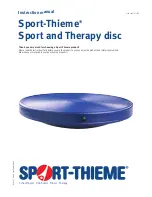
4
Stability on one leg
Starting position: standing on one leg.
1. Swing the free leg forwards and backwards (Ill. 11*).
2. Turn on the vertical axis – apparatus and body together.
3. Pick up objects with the toes (Ill. 10**).
4. Exercises 2 and 3 combined.
5. Guide a ball around the apparatus switching between
standing and free leg. Front stays the same (Ill. 12).
Shifting exercises:
Starting position: straddle position.
1. Alternate shifting of weight***).
2. The same from walking stance (Ill. 9).
*) These exercises provide security for subsequent group
games (kicking at goal with hand or foot etc.).
**) The sand bag and the medicine ball offer the advantage
of staying in place or rolling away slowly; avoids having to
repeatedly step off the apparatus.
***) Important for skiers. The weight can be shifted to the point
where the apparatus‘ edge touches the floor.
Ill. 10
Ill. 9
Ill. 12
Ill. 11
Forward bend and squat
Starting position: basic position
1. Pick up objects from various directions and distances whilst squatting (Ill. 13).
2. Squat with feet either in the forward or backward position (heel or ball on the centre
point). Avoid knock knees and bow legs
(Ill. 14*).
3. Exercises 1 and 2 combined
4. Pick up objects (sand bag) with a rhythmic swing leading up to stretched out horizontal
arms.
5. From basic position into standing scale.
*) The further the knees are pushed forward during the squat without touching each other,
the better the straightening of the pelvis and core.
Ill. 13
Ill. 14
Transitions
1. From standing to kneeling*).
2. From sitting to kneeling.
3. From sitting to standing (Ill. 15).
4. From standing to squatting without touching floor or apparatus edge with the hands.
5. From sitting through squat to kneeling. The feet must not touch the disc surface. (Do not
tense up**)
*) Can be done by a powerful push-up with hands placed on the edge of the disc.
**) Increased breathing before an exercise as well as holding breath during an exercise always lead to uncoordinated moves.
Ill. 15
Instruction manual
for Prod. code 127 7702
School Sports · Club Sports · Fitness · Therapy







